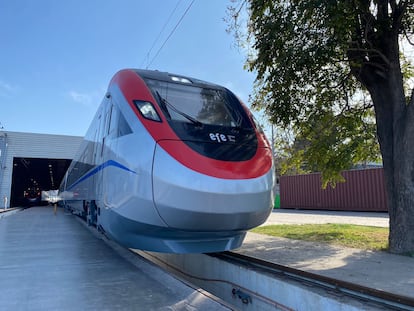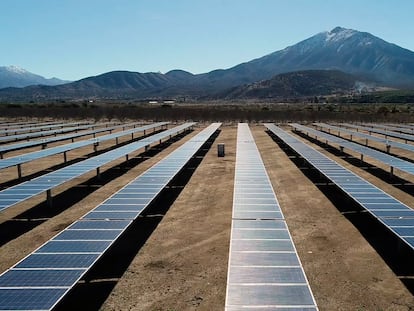Why Chile is home to the fastest trains in South America
The government of Gabriel Boric is set to unveil six new high-speed machines that will cut down the trip between Santiago and Chillán to under four hours


One of the main goals of the Chilean government of Gabriel Boric is to revive the use of trains in the country, which is the longest in the world, with 2,670 miles (4,300 kilometers) of coastline but railway coverage of only about 500 miles (800 kilometers). As part of the plan, the government and Chilean State Railways (EFE) presented two of the six trains that will be incorporated into the fleet that connects the capital, Santiago, with the city of Chillán, located 250 miles (400 kilometers) to the south. The new trains, capable of reaching a speed of 99 miles (160 kilometers) per hour, will shorten the five-hour trip to three hours and 40 minutes.
The Santiago-Chillán route is one of Chile’s two interregional services and the only long-distance network that operates regularly. Its current fleet of six trains — which reach a speed of 87 miles (140 kilometers) per hour — are already the fastest in South America. Second place in that ranking is occupied by the Argentine rail service that connects Buenos Aires with Mar del Plata — a distance of 257 miles (414 kilometers) that takes five hours and 36 minutes to cover, according to figures provided by EFE.
Chilean State Railways, which operates under the Ministry of Transportation, invested $70 million in six high-speed trains, which will be manufactured by the construction company China Railway Rolling Stock Corporation (CRRC). The project was awarded during the right-wing government of Sebastián Piñera in 2020. One of the special features of the trains is that they can automatically switch from electric power to diesel. Currently, Chilean trains run on either diesel or electric.
The first two trains arrived in early March at the port of San Antonio, in the Valparaíso region, near Santiago. The trains are now undergoing a calibration and testing process that will last six months. They are scheduled to start operating during the third and fourth quarters of 2023. The remaining four trains will arrive in Chile in the middle of the year. Once they are incorporated, the plan is for them to replace the current trains on the Santiago-Chillán route. The older trains will be used for other services.
The Ministry of Transportation says the high speeds and lower maintenance costs of the new fleet will allow it to offer 12 daily services, doubling the current number. According to its projections, once the six high-speed trains are operational, the annual number of passengers will increase from 315,000 to 800,000.
At the presentation this week, EFE president Eric Martin said the trains were part of a broader project, including “the restoration of 12 stations, upgrading the track standard and a modern maintenance center.”
The Minister of Transportation and Telecommunications, Juan Carlos Muñoz, added that the “fastest and most modern” trains in South America will offer different services. Some will be used for trips with more stops, connecting not only the regional capitals, but also in-between cities such as San Javier, San Carlos and Parral, where the poet Pablo Neruda was born in 1904.
The modernization of the Santiago-Chillán railway route is part of the “Chile on Rails” project, which continues the plan drawn up by the Piñera government in 2019. The goal of the plan is to triple the number of train passengers to 150 million, and double freight transportation from 10 million to 20 million tons.
Train use in Chile has fluctuated throughout history, reaching a peak in 1972, under the government of Salvador Allende, when there were 27.5 million passengers. During the dictatorship of Augusto Pinochet (1973-1990) more than a third of the country’s railways disappeared. Since the 2000s, inner city rail networks have been strengthened, but the country has yet to achieve its dream of having a train that unites the South American country.
Sign up for our weekly newsletter to get more English-language news coverage from EL PAÍS USA Edition
Tu suscripción se está usando en otro dispositivo
¿Quieres añadir otro usuario a tu suscripción?
Si continúas leyendo en este dispositivo, no se podrá leer en el otro.
FlechaTu suscripción se está usando en otro dispositivo y solo puedes acceder a EL PAÍS desde un dispositivo a la vez.
Si quieres compartir tu cuenta, cambia tu suscripción a la modalidad Premium, así podrás añadir otro usuario. Cada uno accederá con su propia cuenta de email, lo que os permitirá personalizar vuestra experiencia en EL PAÍS.
¿Tienes una suscripción de empresa? Accede aquí para contratar más cuentas.
En el caso de no saber quién está usando tu cuenta, te recomendamos cambiar tu contraseña aquí.
Si decides continuar compartiendo tu cuenta, este mensaje se mostrará en tu dispositivo y en el de la otra persona que está usando tu cuenta de forma indefinida, afectando a tu experiencia de lectura. Puedes consultar aquí los términos y condiciones de la suscripción digital.
More information

Renewable energy boom in Chile takes a toll on electrical grid
Archived In
Últimas noticias
Maduro pleads not guilty before the federal court in New York: ‘I am still the president of Venezuela’
A new test can detect Alzheimer’s from a finger prick
UN team enters Sudanese city of El Fasher after paramilitary massacre: ‘It’s like a ghost town’
A recipe for resistance: Indigenous peoples politicize their struggles from the kitchen
Most viewed
- Gilles Lipovetsky: ‘If you want to live better and fall in love, take Prozac, don’t look to philosophy’
- Alain Aspect, Nobel laureate in physics: ‘Einstein was so smart that he would have had to recognize quantum entanglement’
- Alvin Hellerstein, a 92-year-old judge appointed by Bill Clinton, to preside over Maduro’s trial in New York
- Why oil has been at the center of Venezuela-US conflicts for decades
- Maduro’s downfall puts China’s relationship with Venezuela to the test









































